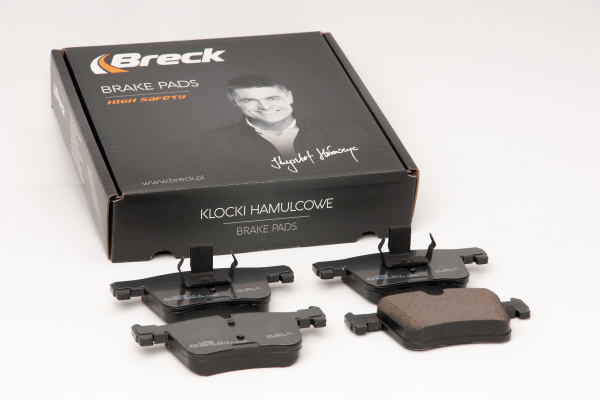
Leading global OE manufacturer and aftermarket supplier of brake friction products LUMAG, alongside its innovative BRECK brand, provides a brief lesson in the evolution of brake pad technology, and the benefits ceramic brake pads can bring.
The beginning
When disc brakes first appeared on production cars in the 1950s, asbestos was the preferred material of choice in brake pads due to its heat resistance and durability. It was also relatively inexpensive compared to other materials at the time, but owing to the environmental and health issues, manufacturers were left searching for a new, safer and more effective alternative.
Organic Brake Pads
Organic brake pads (also known as NAO, or ‘non-asbestos organic’) are made from other non-metallic materials, such as glass, rubber, high-heat resins and Kevlar, and were developed as an alternative to asbestos pads. They have now evolved to offer ‘greener’ benefits than other brake pads as the materials they are made from are easy to dispose of and create less pollutants.
The materials and tools used to manufacture organic brake pads makes them the least expensive on the market today. However, although they are softer and quieter for motorists, they wear more quickly and create considerably more dust than other types of brake pads. They are best suited for normal driving and commuting, therefore are ideal for passenger cars, but are not suitable for performance driving, in part due to the fact that they quickly lose their coefficient of friction when overheated.
Semi-Metallic Materials
The most common brake pad type are semi-metallic pads; as they are crafted of primarily metal they are considered to be extremely durable and can last a long time before replacement is due. Although relatively inexpensive, their metallic composition is a hindrance as well as a help: it can assist in drawing heat away from the rotor and aid in more efficient brake cooling; however, it also means they are prone to more noise and dust. Semi-metallic brake pads have a dramatically increased braking performance and are more resistant to brake fade when compared with organic pads; however, they are more expensive and as they are also more abrasive then other pad types, often means that they wear brake rotors quicker.
Ceramic Brake Pads
The most recent development in friction material technology is the ceramic brake pad. Consisting of a dense ceramic material, it was developed as an alternative replacement for organic and semi-metallic brake pads as at the time, these types produced excessive noise and dust. As they dissipate heat extremely well and are made of an incredibly lightweight material, they are an excellent choice for high-performance vehicles. This type of pad breaks down very slowly, and is also generally easier on rotors than semi-metallic pads.
Lumag’s BRECK brand has developed new-generation ceramic friction materials featuring high friction coefficient stability and to meet the highest safety standards, it put its HIGH SAFETY ceramic brake pads through stringent testing on a dynamometer, with surprising results. Friction material wear of BRECK HIGH SAFETY pads during motorway driving turned out to be 49% lower than that of an alternative OE material, while during city driving the difference reached an astounding 62%.
While other material types are known to be cheaper, one of the advantages of ceramic brake pads is a longer lifespan which goes some way in counterbalancing the extra cost. Also, the other proven benefits, such as those offered by BRECK pads, including improved friction parameters, lack of vibration, limited dust generation, silent operation and efficient vehicle retardation, can offer a real differential in terms of safety and performance for both passenger vehicles and luxury sports cars.
Snapshot: Pros and Cons of brake pad types
Material |
Benefits |
Considerations |
| Semi-Metallic | Readily available; inexpensive; good performance; durable | Causes quicker wear on rotors; heaviest, impacting mileage; needs time to warm up |
| Organic | Quieter; environmentally friendly | Wear quickly; create more dust |
| Ceramic | Best performance; incredibly durable; lightweight | Cost is proportionate to benefits it delivers |
Find out more
For further details on Lumag’s ranges available to the aftermarket, including its own BRECK brand, please call 0121 520 1160 or email office@lumagltd.co.uk. Alternatively, visit www.lumagltd.co.uk to find the latest products.
Ends
Word count: 694
For more information, interviews or images please contact:
Kimberley Hornby, Hornby Whitefoot PR
Tel: 07851610573 E-mail: kimberley@hornbywhitefootpr.co.uk
About LUMAG
With a history spanning almost 30 years, LUMAG was founded in Poland in 1988 by CEO Marek Żak, initially focusing on the production of brake linings before later implementing its own brake pad manufacturing technology. Over the years the company has achieved enormous technological progress, through applied engineering solutions as well as the continuous rise of quality and safety standards.
Since September 2013 it has been operating out of a purpose built new production facility located 60km from Poznań in the town of Budzyń, covering an area of approx. 19,000 square metres, allowing the company to satisfy ever-growing customer needs and to meet strict demands of the OEM market.
The factory features an automated mixing facility, designed and custom-built for the manufacture of friction materials, coupled with high-capacity processing lines. The investment has multiplied its previous production capacity and allowed it to increase its headcount by around 10%.
The company’s mission is to supply car and commercial vehicle users with high-quality products ensuring safe braking, and in doing so, improving the safety of all road users.
LUMAG’s UK operations are based in Doncaster, South Yorkshire.
Further information can be found at www.lumagltd.co.uk.
